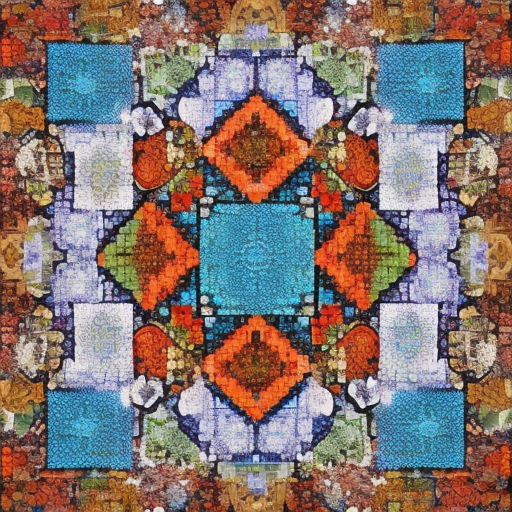Mosaic: A Detailed Summary
Mosaic is an ancient art form that involves creating images or designs by arranging small pieces of colored glass, stone, or other materials. This art form has a rich history that spans thousands of years and can be found in various cultures around the world. From ancient Greece and Rome to Byzantine churches and Islamic architecture, mosaics have been used to decorate and enhance the beauty of buildings, objects, and even public spaces.
History of Mosaic
The origins of mosaic can be traced back to ancient Mesopotamia, where small pieces of colored stones were used to create decorative patterns. However, it was the Greeks who elevated mosaic to a true art form. They used pebbles, shells, and colored stones to create intricate designs on floors, walls, and even furniture. The Romans further developed this art form, using tesserae (small, square pieces of stone or glass) to create more detailed and complex mosaics.
During the Byzantine era, mosaics became an integral part of religious art. Byzantine mosaics adorned the walls and ceilings of churches, depicting religious scenes and figures. The use of gold and vibrant colors made these mosaics truly breathtaking. Islamic art also embraced mosaic, with intricate geometric patterns adorning mosques and palaces.
Techniques and Materials
Creating a mosaic involves several steps and techniques. First, the design is sketched onto a surface, such as a wall or a wooden panel. Then, the artist selects the materials to be used, which can include glass, stone, ceramic, or even precious metals like gold or silver. These materials are then cut into small pieces, called tesserae, which are carefully arranged and adhered to the surface using a strong adhesive.
The artist must consider factors such as color, shape, and texture when arranging the tesserae to create the desired image or pattern. Grouting is then applied to fill the gaps between the tesserae and provide stability. Finally, the mosaic is cleaned and polished to enhance its appearance.
Styles and Themes
Mosaics can be created in various styles and themes, depending on the artist’s vision and the purpose of the artwork. Some common styles include classical, Byzantine, Islamic, and contemporary. Classical mosaics often depict mythological scenes or everyday life, while Byzantine mosaics focus on religious subjects. Islamic mosaics are characterized by intricate geometric patterns, and contemporary mosaics can explore a wide range of themes and styles.
Significance and Preservation
Mosaics have played a significant role in art and culture throughout history. They have been used to convey religious, political, and social messages, as well as to beautify and enhance architectural spaces. Mosaics also serve as a valuable historical record, providing insights into the cultures and societies in which they were created.
Preserving and restoring mosaics is crucial to ensure their longevity and cultural significance. Over time, mosaics can deteriorate due to environmental factors, vandalism, or neglect. Conservation efforts involve cleaning, stabilizing, and repairing damaged mosaics using specialized techniques and materials. In some cases, mosaics are removed from their original location and displayed in museums or cultural institutions to protect them from further damage.
Contemporary Applications
While mosaic has deep roots in history, it continues to be a vibrant and evolving art form in contemporary times. Artists around the world are pushing the boundaries of traditional mosaic techniques, experimenting with new materials and styles. Mosaic artworks can be found in public spaces, galleries, and private collections, adding color and beauty to our modern surroundings.
In conclusion, mosaic is an ancient art form that has captivated and inspired people for centuries. Its intricate designs, vibrant colors, and rich history make it a truly unique and enduring art form. From ancient civilizations to contemporary artists, mosaic continues to be a powerful medium for artistic expression and cultural preservation.












